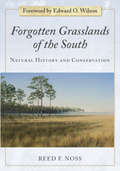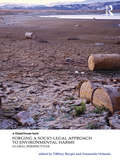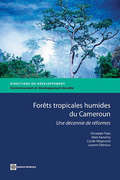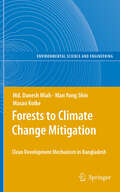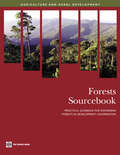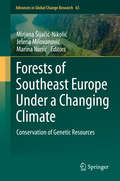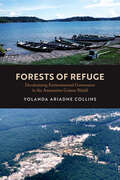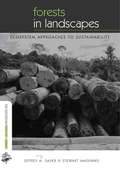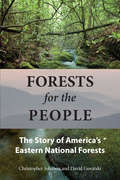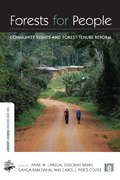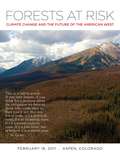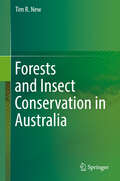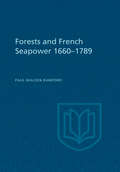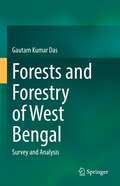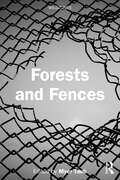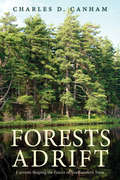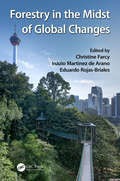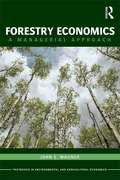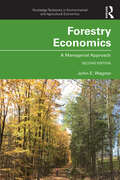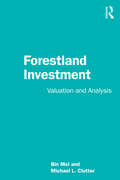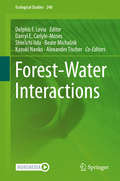- Table View
- List View
Forgotten Grasslands of the South: Natural History and Conservation
by Reed F NossForgotten Grasslands of the South is the study of one of the biologically richest and most endangered ecosystems in North America. In a seamless blend of science and personal observation, renowned ecologist Reed Noss explains the natural history of southern grasslands, their origin and history, and the physical determinants of grassland distribution, including ecology, soils, landform, and hydrology. In addition to offering fascinating new information about these little-studied ecosystems, Noss demonstrates how natural history is central to the practice of conservation. Although theory and experimentation have recently dominated the field of ecology, ecologists are coming to realize how these distinct approaches are not divergent but complementary, and that pursuing them together can bring greater knowledge and understanding of how the natural world works and how we can best conserve it. This long-awaited work sets a new standard for scientific literature and is essential reading for those who study and work to conserve the grasslands of the South as well as for everyone who is fascinated by the natural world.
Forging the Future of Space Science: The Next 50 Years
by National Research Council of the National AcademiesFrom September 2007 to June 2008 the Space Studies Board conducted an international public seminar series, with each monthly talk highlighting a different topic in space and Earth science. The principal lectures from the series are compiled in Forging the Future of Space Science. The topics of these events covered the full spectrum of space and Earth science research, from global climate change, to the cosmic origins of life, to the exploration of the Moon and Mars, to the scientific research required to support human spaceflight. The prevailing messages throughout the seminar series as demonstrated by the lectures in this book are how much we have accomplished over the past 50 years, how profound are our discoveries, how much contributions from the space program affect our daily lives, and yet how much remains to be done. The age of discovery in space and Earth science is just beginning. Opportunities abound that will forever alter our destiny.
Forging a Socio-Legal Approach to Environmental Harms: Global Perspectives (Law, Justice and Ecology)
by Tiffany Bergin Emanuela OrlandoEnvironmental harms exert a significant toll and pose substantial economic costs on societies around the world. Although such harms have been studied from both legal and social science perspectives, these disciplinary-specific approaches are not, on their own, fully able to address the complexity of these environmental challenges. Many legal approaches, for example, are limited by their inattention to the motivations behind environmental offences, whereas many social science approaches are hindered by an insufficient grounding in current legislative frameworks. This edited collection constitutes a pioneering attempt to overcome these limitations by uniting legal and social science perspectives. Together, the book’s contributors forge an innovative socio-legal approach to more effectively respond to, and to prevent, environmental harms around the world. Integrating theoretical and empirical work, the book presents carefully selected illustrations of how legal and social science scholarship can be brought together to improve policies. The various chapters examine how a socio-legal approach can ultimately lead to a more comprehensive understanding of environmental harms, as well as to innovative and effective responses to such environmental offences.
Forêts Tropicales Humides du Cameroun
by Giuseppe Topa Alain Karsenty Carole Megevand Laurent DebrouxEn 1994, le gouvernement camerounais a initié des réformes légales et commerciales visant à réguler les droits d'accès et d'usage des forêts tropicales, qui constituent une richesse incontestable pour le pays. Ces réformes cherchaient à équilibrer les intérêts publics et privés et à plus largement intégrer les perspectives économiques, culturelles et environnementales. Aujourd'hui, plus de 60 pourcent des forêts tropicales du Cameroun sont exploitées selon un plan d'aménagement agréé. L'exploitation illégale dans les forêts aménagées a significativement diminué, la biodiversité est protégée plus efficacement et l'industrie forestière, restructurée, adhère largement aux pratiques de gestion durable reconnues internationalement. Basé sur des données historiques, des recherches spécifiques et des travaux analytiques, 'Forêts tropicale humides du Cameroun : Une décennie de réformes' présente la genèse et le déploiement de ces réformes. Ce livre identifie les politiques qui ont porté leur fruit, celles qui n'ont pas fonctionné et propose des améliorations. Bien que ces réformes aient été élaborées et mises en oeuvre dans un contexte spécifique, les enseignements tirés de cette expérience pourront servir à d'autres pays, connaissant des réalités similaires. Ce livre devrait être notamment utiles aux analystes politiques et experts du développement, ainsi qu'aux gouvernements, aux populations et aux agences de développement des pays riches en forêts tropicales, en Afrique et ailleurs.
Forests to Climate Change Mitigation
by Man Yong Shin Masao Koike Md. Danesh MiahToday, the effect of global climate change is clear to all. It is clearly dangerous in developing countries such as Bangladesh. The industrial revolution caused major changes in technology, socio-economy and cultures in the late 18th and early 19th century, beginning in Britain and spreading throughout the world. The technology dominated economy was mostly dependent on energy produced from fossil fuel, which still holds true today. It is well known that fossil fuel burning has increased the GHGs to the atmosphere, thus creating global warming. Among the GHGs, the concentration of CO2 has been confirmed as the largest. Terrestrial ecosystems are clearly influencing the concentration of GHGs in the atmosphere. Greenhouse gases are constantly entering and leaving the atmosphere. Actively growing trees and other plants absorb CO2 from the atmosphere, combine it with water through photosynthesis and create sugars and more stable carbohydrates. Through this process, trees capture and store atmospheric CO2 in vegetation, soils and biomass products. The Kyoto Protocol, in 1997, explored a flexible mechanism, CDM (Clean Development Mechanism) where Annex I and non-Annex I parties interact for climate change mitigation. Forestry activities have been considered important in the arena of climate change as they act both as a sink and sources of carbon. The purpose of this book is to highlight the means of efficiently reducing global warming through forestry options in Bangladesh and the positive implications of CDM.
Forests Sourcebook
by World BankThe 'Forests Sourcebook' provides practical operations-oriented guidance for forest sector engagement toward the goals of poverty reduction, conservation and economic development. Intended to guide World Bank lending activities and projects, the 'Forests Sourcebook' offers information useful to a broad audience of practitioners, government agencies, and non-governmental organizations. The 'Sourcebook was developed in partnership with members of the Collaborative Partnership on Forests, including the Food and Agriculture Organization. The 'Sourcebook' provides background on key issues, lessons learned, and recommendations for practitioners on a number of topics including private sector engagement, forest governance, sustainable plantation and commercial harvesting, and forest information management systems. Giving insight into the complex interplay between different realms of development work that effect or are affected by forests, the 'Forests Sourcebook' is a valuable tool for any stakeholder involved in development or business projects that could have impact on forests.
Forests of Southeast Europe Under a Changing Climate: Conservation of Genetic Resources (Advances in Global Change Research #65)
by Mirjana Šijačić-Nikolić Jelena Milovanović Marina NonićThis book integrates the different prospective, scientific and practical experience of researchers as well as beneficiaries and stakeholders in the field of forest conservation in Southeast Europe. The book stresses the importance of improving the adaptability of these ecosystems to the impacts of climate change. Gathered around a common idea, the book presents the latest results in forest genetic resources conservation at national and regional level. The chapters are written by experts from: Bosnia and Herzegovina, Bulgaria, Croatia, FYR Macedonia, Greece, Montenegro, Romania, Serbia and Slovenia. The book presents the current state, legal and institutional framework for conservation and management of forest genetic resources, case studies and best practices in the application of different conservation methods and techniques (in situ and ex situ) as well as climate change aspects in this area. This book will be of particular interest to scientists and experts in the field of forestry, environmental protection and rural development, bachelor, master and doctoral students, as well as for anyone interested in the conservation issues fuelled by ethical and economic motives.
Forests of Refuge: Decolonizing Environmental Governance in the Amazonian Guiana Shield
by Dr. Yolanda Ariadne CollinsForests of Refuge questions the effectiveness of market-based policies that govern forests in the interest of mitigating climate change. Yolanda Ariadne Collins interrogates the most ambitious global plan to incentivize people away from deforesting activities: the United Nations–endorsed Reducing Emissions from Deforestation and Forest Degradation (REDD+) initiative. Forests of Refuge explores REDD+ in Guyana and neighboring Suriname, two highly forested countries in the Amazonian Guiana Shield with low deforestation rates. Yet REDD+ implementation there has been fraught with challenges. Adopting a multisited ethnographic approach, Forests of Refuge takes readers into the halls of policymaking, into conservation development organizations, and into forest-dependent communities most affected by environmental policies and exploitative colonial histories. This book situates these challenges in the inattentiveness of global environmental policies to roughly five hundred years of colonial histories that positioned the forests as places of refuge and resistance. It advocates that the fruits of these oppressive histories be reckoned with through processes of decolonization.
Forests in Landscapes: Ecosystem Approaches to Sustainability (The\earthscan Forest Library)
by Jeffrey Sayer�At last a really useful book telling us how all the rhetoric about ecosystem approaches and sustainable forest management is being translated into practical solutions on the ground� CLAUDE MARTIN, WWF INTERNATIONAL �For too long, foresters have seen forests as logs waiting to be turned into something useful. This book demonstrates that forests in fact have multiple values, and managing them as ecosystems will bring more benefits to a greater cross-section of the public� JEFFREY A. MCNEELY, CHIEF SCIENTIST, IUCN �This book demonstrates that [ecosystem approaches and sustainable forest management] are neither alternative methods of forest management nor are they simply complicated ways of saying the same thing. They are both emerging concepts for more integrated and holistic ways of managing forests within larger landscapes in ways that optimize benefits to all stakeholders� ACHIM STEINER AND IAN JOHNSON, FROM THE FOREWORD Recent innovations in Sustainable Forest Management and Ecosystem Approaches are resulting in forests increasingly being managed as part of the broader social-ecological systems in which they exist. Forests in Landscapes reviews changes that have occurred in forest management in recent decades. Case studies from Europe, Canada, the United States, Russia, Australia, the Congo and Central America provide a wealth of international examples of innovative practices. Cross-cutting chapters examine the political ecology and economics of forest management, and review the information needs and the use and misuse of criteria and indicators to achieve broad societal goals for forests. A concluding chapter draws out the key lessons of changes in forest management in recent decades and sets out some thoughts for the future. This book is a must-read for practitioners, researchers and policy makers concerned with forests and land use. It contains lessons for all those concerned with forests as sources of people's livelihoods and as part of rural landscapes. Published with IUCN and PROFOR
Forests for the People: The Story of America's Eastern National Forests
by Christopher Johnson David GovatskiAt the turn of the twentieth century, widespread clearcutting resulted in ecological ruin and devastating fires in America's Eastern forests. A coalition of citizens, organizations, and business and political leaders fought against this pattern, and in 1911, they achieved a landmark victory with the Weeks Act, which protected millions of acres of Eastern forests. Forests for the People tells the fascinating story of this vital legislation and the citizens and organizations that made it a reality. While these protected forests survive today, many of the critical issues facing American forests in the twentieth century persist, and new threats have arisen--including oil shale drilling, invasive species, and development around national parks. In Forests for the People, Christopher Johnson and David Govatski draw upon the lessons and victories of the past to examine the vital issues facing American forests today and illuminate paths to better forest management.
Forests for People: Community Rights and Forest Tenure Reform
by Deborah Barry Anne M Larson Ganga Ram DahalWho has rights to forests and forest resources? In recent years governments in the South have transferred at least 200 million hectares of forests to communities living in and around them . This book assesses the experience of what appears to be a new international trend that has substantially increased the share of the world's forests under community administration. Based on research in over 30 communities in selected countries in Asia (India, Nepal, Philippines, Laos, Indonesia), Africa (Burkina Faso, Cameroon, Ghana) and Latin America (Bolivia, Brazil, Guatemala, Nicaragua), it examines the process and outcomes of granting new rights, assessing a variety of governance issues in implementation, access to forest products and markets and outcomes for people and forests . Forest tenure reforms have been highly varied, ranging from the titling of indigenous territories to the granting of small land areas for forest regeneration or the right to a share in timber revenues. While in many cases these rights have been significant, new statutory rights do not automatically result in rights in practice, and a variety of institutional weaknesses and policy distortions have limited the impacts of change. Through the comparison of selected cases, the chapters explore the nature of forest reform, the extent and meaning of rights transferred or recognized, and the role of authority and citizens' networks in forest governance. They also assess opportunities and obstacles associated with government regulations and markets for forest products and the effects across the cases on livelihoods, forest condition and equity. Published with CIFOR
Forests at Risk: Climate Change and the Future of the American West
by Aspen Center for Environmental StudiesClimate change poses a huge threat to the West. The currmountain pine beetle epidemic with over 50 million acres of dying trees in western North America has created a powerful “teachable moment” across the region. A primary goal of the Forests At Risk symposium was to reframe the nation’s climate change dialogue by making the issue both personal and real to many who may not appreciate its connection to the immediate world around them. While some may have difficulty relating to rising sea levels, falling water tables, imperiled polar bears and melting glaciers in far-off places, they are still shocked by the sight of vast dying forests around their homes. The Forests At Risk symposium explored the statemby Andy Jacobson, a carbon cycle scientist at the National Oceanic and Atmospheric Administration in Boulder, that “this is the kind of feedback we're all very worried about in the carbon cycle ... a warming planet leading to, in this case, an insect outbreak that increases carbon dioxide into the atmosphere, which can increase warming.” The overwhelming scientific consensus holds that climate change is one of the mserious threats facing humankind today. We have a soberingly short time in which to reduce atmospheric greenhouse gases if we are to preserve our quality of life and environment. In addition to the global urgency, the American West is deeply dependon the health of its forests, mountains and streams for both its quality of life and its economy. Put simply, if global warming shortens our winters, diminishes our recreation, and unleashes wildfires, diseases and insect epidemics that devastate our forests, the regional damage would be incalculable. NOW is the perfect time to learn more in this ebook. The Forests At Risk symposium represented the first substantial public forum focused directly on the connection between climate change and forest health in the American West. In the wake of millions of acres of pine beetle devastation across our continent, this is the ideal momto highlight the climate change connection and focus on the question of what happens when our forests transform from carbon sinks into carbon sources.
Forests and Insect Conservation in Australia
by Tim R. NewLosses of forests and their insect inhabitants are a major global conservation concern, spanning tropical and temperate forest regions throughout the world. This broad overview of Australian forest insect conservation draws on studies from many places to demonstrate the diversity and vulnerability of forest insects and how their conservation may be pursued through combinations of increased understanding, forest protection and silvicultural management in both natural and plantation forests. The relatively recent history of severe human disturbance to Australian forests ensures that reasonably natural forest patches remain and serve as ‘models’ for many forest categories. They are also refuges for many forest biota extirpated from the wider landscapes as forests are lost, and merit strenuous protection from further changes, and wider efforts to promote connectivity between otherwise isolated remnant patches. In parallel, the recent attention to improving forest insect conservation in harmony with insect pest management continues to benefit from perspectives generated from better-documented faunas elsewhere. Lessons from the northern hemisphere, in particular, have led to revelations of the ecological importance and vulnerability of many insect taxa in forests, together with clear evidence that ‘conservation can work’ in concert with wider forest uses. A brief outline of the variety of Australian tropical and temperate forests and woodlands, and of the multitude of endemic and, often, highly localised insects that depend on them highlights needs for conservation (both of single focal species and wider forest-dependent radiations and assemblages). The ways in which insects contribute to sustained ecological integrity of these complex ecosystems provide numerous opportunities for practical conservation.
Forests and Global Change
by David A. Coomes David F. R. P. Burslem William D. Simonson David A. Coomes David F. R. P. Burslem William D. SimonsonForests hold a significant proportion of global biodiversity and terrestrial carbon stocks and are at the forefront of human-induced global change. The dynamics and distribution of forest vegetation determines the habitat for other organisms, and regulates the delivery of ecosystem services, including carbon storage. Presenting recent research across temperate and tropical ecosystems, this volume synthesises the numerous ways that forests are responding to global change and includes perspectives on: • the role of forests in the global carbon and energy budgets • historical patterns of forest change and diversification • contemporary mechanisms of community assembly and implications of underlying drivers of global change • the ways in which forests supply ecosystem services that support human lives. The chapters represent case studies drawn from the authors' expertise, highlighting exciting new research and providing information that will be valuable to academics, students, researchers and practitioners with an interest in this field.
Forests and French Sea Power, 1660-1789
by Paul Walden BamfordBy choosing to concentrate upon discovering what forest resources were available to the French navy during the ancien régime and what use it was able to make of them, Mr. Bamford has not only provided the first monograph on that subject in the English language, but has gone far toward explaining why France was the loser in the long duel with England for the control of commerce and the extension of empire. <P><P> Two years of research in the Archives Nationales and in the Archives de la Marine in Paris, Toulon, and Rochefort enabled him to draw on contemporary sources of information of which little, if any, use has been made before, and a further year of research in the libraries of New York City, particularly in the rich Proudfit Naval Collection, also yielded new material. It is Mr. Bamford's achievement to have handled this vast store of primary sources with such skill and judgement that the reader, by turning over letters from disgruntled forest proprietors, reports from harassed maîtres on the trickery and recalcitrance of the peasants, instructions from the top echelon of the navy to inspectors in the forests, and a variety bills, receipts, and memoranda, is given at first hand an appreciation of the difficulties faced by the navy in trying to obtain timber and masts of the choice quality required for building ships-of-the-line. The navy had to compete with the merchant marine and with industrial and private users of fuel for supplies that were continually being depleted by mismanagement and by the conversion of forests to arable land. Measures, superficially admirable, for conserving the forests are found on closer examination to be at once over-precise and not properly enforced. Transport, even in a country so abundantly supplied with navigable rivers as France, was expensive and difficult.<P>Not only historians, but scholars in the field of forestry, economics, geography, agriculture, and transport will find this book illuminating.
Forests and Forestry of West Bengal: Survey and Analysis
by Gautam Kumar DasThis book explains several basic concepts of forests and forestry research like social distancing of trees, solitary trees, green infrastructure of trees including typical forest stands like pocket forests, forgotten forests, community forests, and social forestry from one forest stand to another scattered in the districts of West Bengal. In the field of forest floors, depleting status of the forests stimulates to find out different models of afforestation programme like tree-island and rescue forest strategy through plantation programme. Huge loss of tree canopy ravaged by the series of cyclonic storms particularly in the districts of South Bengal seems to be recovered by bioeconomic model with the implementation of social forestry schemes. Thoughts of such models incited the author to go through statistical analysis on different matters and parameters of the forest stands. Determination of physico-chemical parameters of the forest soil are carried on hand in hand with the identification of Alfisol profile exposures in the forest floors. For finding out the present status of forests, district-wise review is worked out. Though scattered in the format of the forest patches, forest stands in the Jungle Mahal are remarkably interesting for any surveyor or tree-lover. Because of the reasons, surveys in the specific forest lands like Joypur and Beliatore of Bankura district and Garh Jangal and Aduria Forests under Bardhaman Forest Division are given special impetus for statistical measures, soil properties analysis, and identification of vegetation pattern. All these salient features inspire the author to take an attempt disseminating information and related characteristics of the forests and forestry of West Bengal. Researchers and students will get sufficient material from this book to enrich their knowledge on the forest environment and the author believes that this book will act as the pioneer work for the flourishment and amelioration of the forestry of West Bengal.
Forests and Fences (WildZones)
by Myer TaubThis book examines critical themes in environmental studies though theatre and performance studies. It experiments with forms along with the practice of praxis to provide radical frameworks for resilience in the contemporary age of crisis. Drawing on Ravi Sundaram’s concept of “Wild Zones”, it explores the kinetic overflows in informal sites, but also in the intimate spaces that have been realigned or shocked or fenced in, especially in the context of the COVID-19 pandemic.This volume will be of great interest to scholars and researchers of theatre and performance studies, environment and sustainability, and environmental humanities.
Forests Adrift: Currents Shaping the Future of Northeastern Trees (The Future Series)
by Charles D. CanhamA captivating analysis of the past, present, and future of northeastern forests and the forces that have shaped them The northeastern United States is one of the most densely forested regions in the country, yet its history of growth, destruction, and renewal are for the most part poorly understood—even by specialists. In this engaging look at both the impermanence and the resilience of the northeastern forest ecosystems, Charles D. Canham provides a synthesis of modern ecological research and explores critical threats that include logging, fire suppression, disease, air pollution, invasive species, and climate change. Providing a historical perspective on how northeastern forests have changed since the arrival of European settlers, Canham also utilizes new theoretical models to predict how these ecosystems will change and adapt to an uncertain future. This is an informed and accessible investigation of an endangered natural landscape that examines the ramifications of the scientific controversies and ethical dilemmas shaping the future of northeastern forests.
Forests: Five case studies (Environmental and Resource Economics Set)
by Tom Jones Soren WibeThe economic value of forest. has long been recognized, but the ways in which that value is calculated and the management policies adopted in consequence have all too often resulted in overuse and irreversible destruction. This is spectacularly obvious around the Mediterranean basin, but it is also true in northern Europe. These five case studies, commissioned by the OECD, examine failures of forest management in Britain, Spain, Italy, Germany and Sweden. They look at both market and intervention policies and show how each can further the destruction of the forests, and they set out ways in which future policies can evade the mistakes of the past. Originally published in 1992
Forestry in the Midst of Global Changes
by Christine Farcy Eduardo Rojas-Briales Inazio Martinez de AranoForestry today, like many other sectors that traditionally rely on material goods, faces significant global drivers of societal change that are less often addressed than the environmental concerns commonly in the spotlight of scientific, political, and news media. There are three major interconnected issues that are challenging forestry at its foundation: urbanization, tertiarization, and globalization. These issues are at the core of this book. The urbanization of society, a process in development from the first steps of industrialization, is particularly significant today with the predominance and quick growth rate of the world’s urban population. Ongoing urbanization is creating new perspectives on forestry, inducing changes in its social representation, and changing lifestyles and practices with a tendency toward dematerialization. The process of urbanization is also creating a disconnect and in some ways is leaving behind rurality, the sector of society where forestry has traditionally developed and taken place over centuries. The second issue covered in this book is the tertiarization of the economy. In society today, the sector of services largely dominates the economy and occupies the major part of the world’s active population. This ongoing process modifies professional modalities and ways of life and opens new doors to forests through the immaterial goods they provide. It also profoundly changes the framework, rules, processes, means of production, exchanges between economic factors, and the processes of innovation. The third issue is undoubtedly globalization in its economic, political, and social components. Whether it’s through bridging distances, crossing borders, accelerating changes, standardizing practices, leveling hierarchical structures, or pushing for interdependence, globalization impacts everyone, everywhere in multiple ways. Forestry is no exception. Forestry in the Midst of Global Changes focuses on these global drivers of change from the perspective of their relationships with how society functions. By analyzing them in depth through multidisciplinary, interdisciplinary, and even transdisciplinary approaches, this book is helping to design the forestry of tomorrow.
Forestry Economics: A Managerial Approach (Routledge Textbooks In Environmental And Agricultural Economics Ser.)
by John E. WagnerForestry Economics introduces students and practitioners to all aspects of the management and economics of forestry. The book adopts the approach of managerial economics textbooks and applies this to the unique processes and problems faced by managers of forests. While most forestry economics books are written by economists for future economists, what many future forest and natural resource managers need is to understand what economic information is and how to use it to make better business and management decisions. John E. Wagner draws on his twenty years of experience teaching and working in the field of forest resource economics to present students with an accessible understanding of the unique production processes and problems faced by forest and other natural resource managers. There are three unique features of this book: The first is its organization. The material is organized around two common economic models used in forest and natural resources management decision making. The second is the use of case studies from various disciplines: Outdoor and Commercial Recreation, Wood Products Engineering, Forest Products, and Forestry. The purpose of these case studies is to provide students with applications of the concepts being discussed within the text. The third is revisiting the question of how to use economic information to make better business decisions at the end of each chapter. This ties each chapter to the preceding ones and reinforces the hypothesis that a solid working knowledge of these economic models and the information they contain are necessary for making better business decisions. This textbook is an invaluable source of clear and accessible information on forestry economics and management for not only economics students, but for students of other disciplines and those already working in forestry and natural resources.
Forestry Economics: A Managerial Approach (Routledge Textbooks in Environmental and Agricultural Economics)
by John E. WagnerForestry Economics introduces students and practitioners to the economics of managing forests and forest enterprises. The book adopts the approach of managerial economics textbooks and applies this to the unique problems and production processes faced by managers of forests and forest enterprises. What many future forest and natural resource managers need is to understand what economic information is and how to use it to make better business and management decisions. John E. Wagner draws on his 30 years of experience teaching and working in the field of forest resource economics to present students with an accessible understanding of the unique production processes and problems faced by forest and other natural resource managers. The second edition has been updated to include: Expanded discussion of compounding, discounting, and capital budgeting, as well as an expanded discussion of when to replace a capital asset that has (i) costs but no direct revenue stream such as a machine; (ii) costs and a direct annual revenue stream such as a solar array; or (iii) costs and a periodic revenue stream illustrated by the forest rotation problem. New practical examples to provide students with applications of the concepts being discussed in the text, most notably on New Zealand and a Radiata Pine (Pinus radiata) Plantation. A brand-new chapter that develops business plans for for-profit businesses to illustrate how a business plan is derived from the economic information contained within the Architectural Plan for Profit and how it can be used to make business decisions about continuing to operate a business or to start a new business. This textbook is an invaluable source of clear and accessible information on forestry economics and management not only for economics students, but also for students of other disciplines and those already working in forestry and natural resources.
Forestry Economics: A Managerial Approach (Routledge Textbooks in Environmental and Agricultural Economics)
by John E. Wagner- Each chapter introduces one or more key concepts in managerial economics and then illustrates the importance of those ideas by showing how they can be applied when making business decisions.- The inclusion of numerous case studies throughout the book enables students to see how forestry and natural resource management works in practice.- A new chapter on developing and writing business plans highlights a managerial tool and allows students to put the ideas developed throughout the book into practice.
Forestland Investment: Valuation and Analysis
by Bin Mei Michael L. ClutterForestland investment has surged in the past few decades as a result of land ownership change in the forestry industry. Timberland investment and management organizations and real estate investment trusts have bought up land and resources that were divested by vertically integrated forest products companies. This book provides a seminal coverage of this seismic shift in the industry, exploring the philosophy, driving factors, valuation, theory, research, implementation, practice, and effects of forestland investment. Across 15 chapters the book reviews the history of forestland investment; discusses the optimal forest rotation; explains timberland appraisal; examines the return drivers of forestland; analyzes timberland index construction methods and results; prices timberland assets; reviews financial and real options; investigates real option values in forestland management; evaluates timber harvest contracts; examines new opportunities in the emerging woody bioenergy market; and eventually offers prospects on forestland investment in the future. It also discusses how forest carbon can be used as a nature-based climate solution. This book is essential reading for forestry business students and scholars, as well as practitioners and policymakers in the industry.
Forest-Water Interactions (Ecological Studies #240)
by Delphis F. Levia Darryl E. Carlyle-Moses Shin’ichi Iida Beate Michalzik Kazuki Nanko Alexander TischerThe United Nations has declared 2018-2028 as the International Decade for Action on Water for Sustainable Development. This is a timely designation. In an increasingly thirsty world, the subject of forest-water interactions is of critical importance to the achievement of sustainability goals. The central underlying tenet of this book is that the hydrologic community can conduct better science and make a more meaningful impact to the world’s water crisis if scientists are: (1) better equipped to utilize new methods and harness big data from either or both high-frequency sensors and long-term research watersheds; and (2) aware of new developments in our process-based understanding of the hydrological cycle in both natural and urban settings. Accordingly, this forward-looking book delves into forest-water interactions from multiple methodological, statistical, and process-based perspectives (with some chapters featuring data sets and open-source R code), concluding with a chapter on future forest hydrology under global change. Thus, this book describes the opportunities of convergence in high-frequency sensing, big data, and open source software to catalyze more comprehensive understanding of forest-water interactions. The book will be of interest to researchers, graduate students, and advanced undergraduates in an array of disciplines, including hydrology, forestry, ecology, botany, and environmental engineering.
